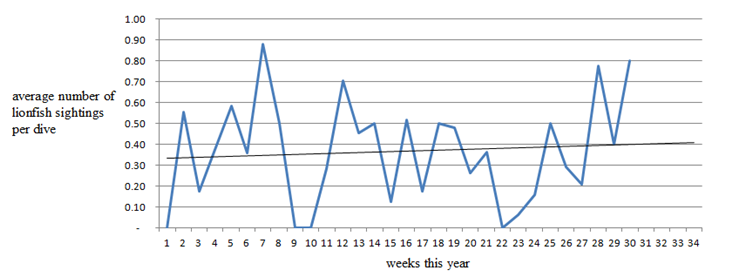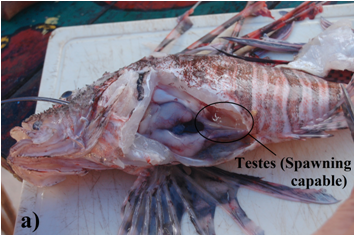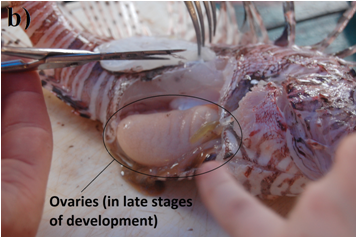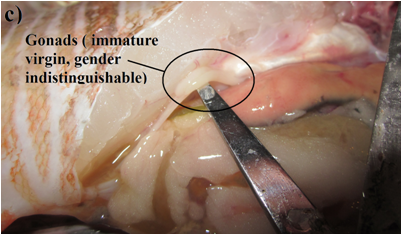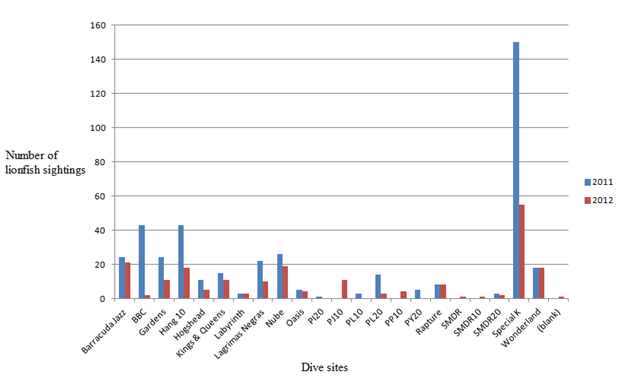By Alice Hawkes | Charitable Trust Team
The invasion of lionfish, native to the Indo-Pacific, into the Atlantic and Caribbean Sea is not only one of the most rapid in marine history but also having extremely detrimental effects to local species and ecosystems.
Recently introduced via un/intentional release, they have spread extremely quickly throughout the Caribbean, since their first sightings around Florida in 2000, they have spread as far south as Venezuela within 10 years1.
While in their native habitat, lionfish breed seasonally, invasive lionfish in the Atlantic have been documented breeding all-year round2. They can produce between 4000 and 30,000 eggs each time they spawn which are then dispersed great distances along oceanic surface currents, during an estimated pelagic larval duration of 20 to 35 days, before settlement3. Unlike other fish species, Lionfish can settle on and inhabit nearly all marine habitat types and depths between surface levels to over 300m, in temperatures between10-35 degrees Celsius4,5. However, with the rising sea temperatures due to global warming, this potentially invasive region is increasing. Lionfish are also generalist carnivores that can consume over 70 species of fish, up to half their own body length, including commercially, recreationally, and ecologically important species6. On heavily invaded sites, lionfish consume native fish at unsustainable rates. As such, food competition can also lead to depleting food sources for native carnivores.
Here at Pez Maya we have been collecting information on the invasive lionfish so as to document its effects on the local ecosystem. So far this year the average number of sightings per dive per week has been slowly increasing.
As well as a steady increase in the average number of sightings per dive, there is also a noticeable increase in the sizes of lionfish seen on our dive sites. This general increase in size supports theories that invasive lionfish are larger than they are in their native ranges7, suggesting higher levels of local prey consumption and lionfish reproduction this year. In fact, we caught three individuals, one male and two females, that had fully developed and spawning capable gonads or very developed gonads nearing spawning capability.
Lionfish can inhabit nearly all habitat types, including important nursery areas such as mangroves and lagoon areas, and other areas with high levels of trophic interaction such as the fore-reef and reef crest. As such we have frequently observed lionfish within the reserve at our inner-reef dive sites, such as “Gardens”, which are commonly used as a nursery habitat for juvenile reef fish.
Invasive adult lionfish, however, have been documented as having a preferred microhabitat of complex topographical structures, especially overhanging structures, and lots of coral cover8, such as our dive site “Special K”. As such, the invasive lionfish exhibited similar patterns of microhabitat occupancy as two local, and already over fished, species; the Grouper and Snapper complex, as seen at our local dive site “Hang 10”. The additional stress put on these species through this direct food competition is hindering any efforts to replenish the declining Grouper and Snapper populations.
As discussed before, on heavily invaded reefs lionfish can consume prey faster than their production on, or recruitment to, the reef. As such, the additional stress put on these species through this direct food competition is hindering any efforts to replenish the declining Grouper and Snapper populations. Also, the lionfish is having a negative impact on the Meso-American barrier reef system through the unsustainable consumption of newly recruited herbivorous species by invasive lionfish is limiting algal grazing on a reef system that is already in threat of a shift to an algal dominated reef.
Lionfish feed primarily on teleosts, fish with bony skeletons, which include the majority of the local marine species, and few other crustaceans, primarily shrimps, more commonly consumed by smaller classes of lionfish. However, lionfish are generalist consumers and will quickly abandon their usual diet for any abundant food source.
Because lionfish captured and removed from an area would “be replaced largely through larval recruitment rather than migration of older individuals”9, “localized control efforts would need to be carried out frequently in order to maintain a younger, smaller population”10, which can be very costly and makes eradication programs extremely difficult.
However, the data collected here is very useful for future planning of local control efforts and will hopefully be used to co-ordinate our future lionfish control efforts which, if implemented well, can control local populations and even generate income for local communities. Also, and possibly more importantly, lionfish ceviche is a very welcome addition to base cuisine
---
1: Morris, J (2009): Biology, Ecology, Control and Management of the Invasive Indo-Pacific Lionfish: An Updated
ntegrated Assessment
2: Morris, J (2011): Oogenesis and spawn formation in the invasive lionfish (Pterois volitans)
3: Green, S (2011): Potential effects of climate change on a marine invasive: The importance of current context
4: Biggs, C (2011): Multi-scale habitat occupancy of invasive lionfish (Pterois volitans) in coral reef environments of Roatanm Hondorus
5: Kimball, M: (2004) - Thermal tolerance and potential distribution of invasive lionfish (Pterois volitans/ miles complex) on the east coast of the United States.
6: Green, S (2012): Invasive Lionfish Drive Atlantic Coral Reef Fish Declines
7: Green, S (2011): Indo-Pacific lionfish are larger and more abundant on invaded reefs: a comparison of Kenyan and Bahamian lionfish populations
8: Biggs, C (2011): Multi-scale habitat occupancy of invasive lionfish (Pterois volitans) in coral reef environments of Roatanm Hondorus
9: Barbour, A: (2011): Evaluating the Potential Efficacy of Invasive Lionfish (Pterois volitans) Removals.
10: Ibid
Project reports on GlobalGiving are posted directly to globalgiving.org by Project Leaders as they are completed, generally every 3-4 months. To protect the integrity of these documents, GlobalGiving does not alter them; therefore you may find some language or formatting issues.
If you donate to this project or have donated to this project, you can receive an email when this project posts a report. You can also subscribe for reports without donating.
Support this important cause by creating a personalized fundraising page.
Start a Fundraiser